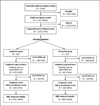A randomized, controlled trial to increase discussion of breast cancer in primary care
- PMID: 24762560
- PMCID: PMC4167008
- DOI: 10.1158/1055-9965.EPI-13-1380
A randomized, controlled trial to increase discussion of breast cancer in primary care
Abstract
Background: Assessment and discussion of individual risk for breast cancer within the primary care setting are crucial to discussion of risk reduction and timely referral.
Methods: We conducted a randomized controlled trial of a multiethnic, multilingual sample of women ages 40 to 74 years from two primary care practices (one academic, one safety net) to test a breast cancer risk assessment and education intervention. Patients were randomly assigned to control or intervention group. All patients completed a baseline telephone survey and risk assessment (via telephone for controls, via tablet computer in clinic waiting room before visit for intervention). Intervention (BreastCARE) patients and their physicians received an individualized risk report to discuss during the visit. One-week follow-up telephone surveys with all patients assessed patient-physician discussion of family cancer history, personal breast cancer risk, high-risk clinics, and genetic counseling/testing.
Results: A total of 655 control and 580 intervention women completed the risk assessment and follow-up interview; 25% were high-risk by family history, Gail, or Breast Cancer Surveillance Consortium risk models. BreastCARE increased discussions of family cancer history [OR, 1.54; 95% confidence interval (CI), 1.25-1.91], personal breast cancer risk (OR, 4.15; 95% CI, 3.02-5.70), high-risk clinics (OR, 3.84; 95% CI, 2.13-6.95), and genetic counseling/testing (OR, 2.22; 95% CI, 1.34-3.68). Among high-risk women, all intervention effects were stronger.
Conclusions: An intervention combining an easy-to-use, quick risk assessment tool with patient-centered risk reports at the point of care can successfully promote discussion of breast cancer risk reduction between patients and primary care physicians, particularly for high-risk women.
Impact: Next steps include scaling and dissemination of BreastCARE with integration into electronic medical record systems.
©2014 American Association for Cancer Research.
Conflict of interest statement
No potential conflicts of interest were disclosed.
Figures
References
-
- NCCN Guidelines® and Derivative Information Products: User Guide. National Comprehensive Cancer Network; 2013.
-
- Peplonska B, Lissowska J, Hartman TJ, Szeszenia-Dabrowska N, Blair A, Zatonski W, et al. Adulthood lifetime physical activity and breast cancer. Epidemiology. 2008;19:226–236. - PubMed
-
- Silvera SA, Jain M, Howe GR, Miller AB, Rohan TE. Energy balance and breast cancer risk: a prospective cohort study. Breast Cancer Res Treat. 2006;97:97–106. - PubMed
-
- Zhang SM, Lee IM, Manson JE, Cook NR, Willett WC, Buring JE. Alcohol consumption and breast cancer risk in the Women's Health Study. Am J Epidemiol. 2007;165:667–676. - PubMed
-
- Physical activity and good nutrition: Essential elements to prevent chronic diseases and obesity at a glance. Atlanta, GA: National Center for Chronic Disease Prevention and Health Promotion, United States Department of Health and Human Services; 2003. - PubMed
Publication types
MeSH terms
Grants and funding
LinkOut - more resources
Full Text Sources
Other Literature Sources
Medical


